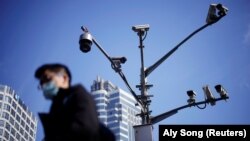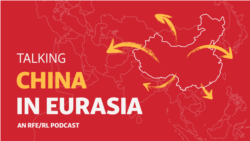Welcome back to the China In Eurasia briefing, an RFE/RL newsletter tracking China's resurgent influence from Eastern Europe to Central Asia.
Tune in to Talking China In Eurasia, a new podcast hosted by me that will air live on Twitter Spaces today and later be available on RFE/RL's website, Apple Podcasts, Spotify, and wherever else you like to listen. We will be taking questions live starting at 3 p.m. CET/9 a.m. EST and I'll be joined by RFE/RL Belgrade bureau chief Maja Zivanovic and Stefan Vladisavljev from Belgrade's Foundation BFPE. Tune in here.
I'm RFE/RL correspondent Reid Standish and here's what I'm following right now.
Surveillance Tech In The Balkans
An RFE/RL investigation documented a murky operation by Serbian law enforcement during nationwide protests in 2021 that showed how officials could abuse cutting-edge Chinese surveillance tools in the future. Read Part 1 and Part 2 here.
Finding Perspective: Serbia has already deployed thousands of surveillance cameras across the country as part of plans to introduce some 8,000 Chinese-made Huawei surveillance cameras with facial-recognition capabilities.
But the rollout has faced public resistance for years from privacy activists and human rights groups.
Due to the pressure, Belgrade says that facial-recognition software is not yet deployed, but the use -- and potential abuse -- of the technology has been a source of rising alarm and our reporting shows why.
When monthlong, nationwide environmental protests broke out in 2021 across Serbia, police began an operation with plainclothes officers to film and catalogue the protesters, including using new devices from Huawei, the Chinese technology giant.
Following the demonstrations, thousands of protesters received fines in the mail. While many said they were stopped and identified by police at the protests, others say they never were, which led to new fears that facial recognition was already in use despite it being illegal.
Our investigation did not find any instances of facial-recognition software being used at the protests or elsewhere in Serbia.
But reporting based on court documents, police testimony, misdemeanor warrants issued to protesters, Interior Ministry documents, and interviews with experts, officials, and activists shows that Serbian law enforcement conducted a widespread operation that raises new concerns about how Serbian officials could abuse cutting-edge Chinese surveillance tools like facial-recognition software.
Why It Matters: One of the leading concerns around facial recognition and its spread from Chinese vendors like Huawei is that it can be used to strengthen authoritarian regimes and be abused to curb dissent rather than its stated use of helping law enforcement pursue and locate criminals and terrorists.
This makes Serbia a vital test case for Chinese surveillance infrastructure beyond its borders, especially given that the country's political climate has seen a chill under the leadership of President Aleksandar Vucic, which is explained in more detail here.
Read More
● Want to know more about Chinese surveillance tech in Serbia and elsewhere? Then tune in to Talking China In Eurasia today at 3 p.m. CET/ 9 a.m. EST. You can listen live here and find the episode on RFE/RL's site and wherever you listen to your podcasts.
● Both the United States and Britain recently deepened bans on Chinese surveillance technology in their countries. London said that it will be restricting Chinese-made surveillance equipment from sensitive sites including government buildings, whereas the Federal Communications Commission (FCC) voted to ban sales of new telecom and surveillance equipment made by several Chinese companies due to national security concerns.
Expert Corner: Putting China's Protests In Context
Readers asked: "What's next for China's anti-COVID lockdown protests? How will the government respond?"
"It would be a mistake to assume that the leadership around Xi Jinping wants to desperately find a way out of the zero-COVID measures to jump-start the economy and reestablish social stability. The zero-COVID policy has not only been in place to save lives in light of low vaccination rates, but has also contributed to strengthening Xi's approach to absolute societal control.
"At the 20th Party Congress, Xi oozed great confidence in his detrimental zero-COVID approach. He will be willing to pay a high price to prove himself and the party right. This will include partial easing of measures, which will lead to greater infections. That does not necessarily have to undermine his policies -- in the end, the party controls the reality: it can manipulate statistics, death figures, and make sure the result is what the party wants it to be." -- Janka Oertel, director of European Council on Foreign Relations' Asia program
"Many people in China don't have an idealized view of Western-style democracy. There are many protesting who might want regime change in China, but that's not necessarily the most widespread view. But what people are calling for is that they want a government that lives up to its promises of people-centered policies, which aren't being delivered right now.
"If the government takes an extremely repressive stance, then things will likely escalate and there will be more contention and violence. But I suspect the government will aim to regroup by doing what it normally does: partly placating people and partly repressing them." -- Kerry Brown, director of the Lau China Institute at King's College London
Do you have a question about China's growing footprint in Eurasia? Send it to me at StandishR@rferl.org or reply directly to this e-mail and I'll get it answered by leading experts and policymakers.
Three More Stories From Eurasia
1. More On China's Protests
After nearly three years of strict COVID restrictions, Chinese leader Xi is facing one of his greatest challenges as thousands of people took to the streets to protest against the government's uncompromising controls and suppression of freedom of speech.
What You Need To Know: In rare and stunning scenes, demonstrations began on November 25 and have since spread to at least 16 locations across China, including its largest cities like the capital, Beijing, and its financial center, Shanghai.
The catalyst for the outpouring of dissent was a building fire in Xinjiang that left 10 dead and anger erupted toward the restrictive so-called zero-COVID policies that have left many sealed in their homes, sent to quarantine centers, or barred from traveling while subjecting people to endless rounds of testing, lockdowns, and surveillance.
"The root cause of these protests is direct discontent with the central government's and Xi Jinping's COVID policy -- not some local issue," Sari Arho Havren, a China expert and adjunct professor at the George C. Marshall European Center for Security Studies, told me. "The spontaneous spread of the protests across major cities is a clear challenge to the [Communist] Party."
All eyes are now on how the government will move to deal with the public anger. Already we're seeing a relaxing of COVID policies in some areas, coupled with an increasingly forceful security presence in others.
"If the protests don't soon die out on their own and instead start spreading even further, we can expect heavy-handed repression as a response," Arho Havren said.
She adds that national authorities could look to place the blame on local officials for the incidents that have sparked anger in hopes of drawing oxygen out of the protests.
"That could be the way Xi Jinping -- the owner of the zero-COVID policy -- spins out the blame elsewhere," she said. "Some cities have already eased their rules and the focus of the official narrative seems to be on mistakes that have been made on the local level."
2. Mr. Michel Goes To Beijing
European Council President Charles Michel is en route to Beijing, where he will meet with Xi, making him the first Western official to visit China since the protests began.
What It Means: It's an awkward position for Michel, who will meet with Xi on December 1.
The visit was initially designed as a way to restart Brussels' relationship with China, which has come under strain the last few years amid tit-for-tat sanctions, the Ukraine war, and shifting strategic priorities across Europe.
Now Michel will need to decide whether to shift his plans and raise the protests in support of the European values that are enshrined in EU strategy or avoid the subject in hopes that it could smooth over the very rough edges of Brussels and Beijing's ties.
How the protests develop in the coming days will likely influence Michel's reaction -- and the chance that Xi could cancel at the last minute is also on the table if the protests grow.
3. How Much Leverage Does Xi Have Over Putin?
Beijing has continued to send signals that it is becoming increasingly uncomfortable with Russia's invasion. Can Xi help bring an end to Moscow's war? We explored this question in the last episode of Talking China In Eurasia, where I was joined by Raffaello Pantucci.
The Details: As Xi Jinping stepped back out onto the world stage at the G20 summit in Bali, it was another litmus test for his support for Russian President Vladimir Putin.
Western leaders, including French President Emmanuel Macron, also called for China to play a larger mediating role. How should these developments be interpreted? How close are Xi and Putin in reality? Is this a sign of a new direction for Chinese diplomacy or just the latest phase of its ongoing balancing act?
Listen here -- and don't forget to subscribe on Spotify, Google, or Apple Podcasts.
Across The Supercontinent
Taiwan's Elections: The ruling Democratic Progressive Party received a major blow in recent local elections, leading to Taiwanese President Tsai Ing-wen resigning as party leader.
The opposition Nationalist Party, which scored big wins in the vote, is seen as more friendly toward Beijing, and some analysts see the election as setting the stage toward easing some tensions with China.
Oil Glut: According to China's latest customs data, Beijing continued to boost Russian energy imports in October, as purchases of natural gas, coal, crude oil, and oil products increased to nearly $60 billion since the invasion of Ukraine, from about $35 billion a year ago.
Ties That Bind: Putin proposed creating a "gas union" with Kazakhstan and Uzbekistan to establish a mechanism to ship natural gas between the three countries and to other countries, including China, RFE/RL reported.
A Gold Rush?: Al-Jazeera produced a new documentary on the rise of Chinese investors in Afghanistan in the wake of the Taliban's takeover and found that many are leaving the country frustrated and disillusioned.
One Thing To Watch
Did Washington and Beijing cut a deal amid the Ukraine war?
According to a new book -- Overreach by Owen Matthews -- there was a U.S.-China deal to try and de-escalate the war that involved Washington blocking Poland's attempt to send aging MiG-29 jets to Ukraine and Beijing agreeing to not supply Russia with military equipment that it needs and also warning the Kremlin against any nuclear escalation.
That's all from me for now. Don't forget to send me any questions, comments, or tips that you might have.
Until next time,
Reid Standish
If you enjoyed this briefing and don't want to miss the next edition, subscribe here. It will be sent to your in-box on the first and third Wednesdays of each month.










